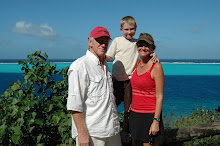And now something for the boat geeks and gear heads .... fuel and boat issues.
Having enough fuel to get where we are going is high priority! We know how far we have to go and how much fuel we stared with, but other than that it seems to be as much art as science. At each RPM seting on our engine we get different fuel flow rates and boat speeds. It seems simple, but the sea conditions, ocean currents, and the whims of King Neptune all impact our speed. We also have to generate electricity for our refrigerators, lights, navigation equipment, water maker, air conditioning, etc. On Oso, we are running a 16kw generator continuously, which consumes just under 1 gallon per hour and needs to be added to the engine fuel use. For our Marquesas passage, we will use 400 gallons of fuel just to make electricity.
When we are in our normal cruising, where we don't have to worry about long range, we run at around 8.5 - 9.0 kts. At that speed, we would not have enough fuel to reach the Marquesas, so we have to balance speed and range.
The normal useable fuel capacity for our Nordhavn 64 is approximately 3000 gallons and we chose to add an additional 300 gallons in a rubber fuel tank for extra range. We don't know of any other Nordhavn 64/68 that has made this long a passage, so we did not have actual range data and it gave us comfort in our planning knowing we could make it easily. As it looks today, we will arrive with close to 1000 gallons in reserve.
We started out this passage running at 1100 rpm, which is a very low power setting for this boat. That gave us approximately 6.4 kts through the water and burned 4.0 gph for 1.6 mpg (+ generator use). After a few days, we were comfortable with our fuel levels and raised to 1200 rpm which gave us approximately 5.0 gph at 7.1 k for 1.4 mpg. It doesn't seem like much, but 1/4 of a gallon per hour over 2700 miles adds up. When we hit our 1/2 way point, we will look at the weather forecast and our remaining fuel and expect to speed up a little more. Do to fuel consumption and high food consumption, Oso is also over 5000 lbs lighter than when we left PV, so we are a little more efficient.
Boat issues:
Oso Blanco has been cruising along with few problems. We regularly do engine room checks and monitor temperatures, fluid levels, and general impressions. Noises are often the first indication of a change or problem. We have over 12,000 nm miles logged over the last 2 yrs, so we have a good idea what is 'normal'. One of the most important systems on the boat is the hydraulic system, which powers our stabilizers. These minimize any rolling from wave action and are critical to our comfort. Yesterday, the port side stabilizer (fin) began making a distinct clicking noise. The potential loss of one of our stabilizers is a cause for high anxiety, so we dug deeper into the cause. Jeff and Karl spent a couple hours crawling around in a small space. We had assumed we were having a bearing failure, but eventually found the yoke on the hydraulic cylinder has slipped down on the shaft and was wearing a groove into the bottom plate. We greased it as a temporary fix and will consider a permanent adjustment if we have smooth seas this afternoon, or when we get to the Marquesas. From a boat maintenance point of view, this is a very boring trip and we hope to keep it that way. These boats are designed and built to cross oceans and Oso Blanco seems to love it.
Eric

